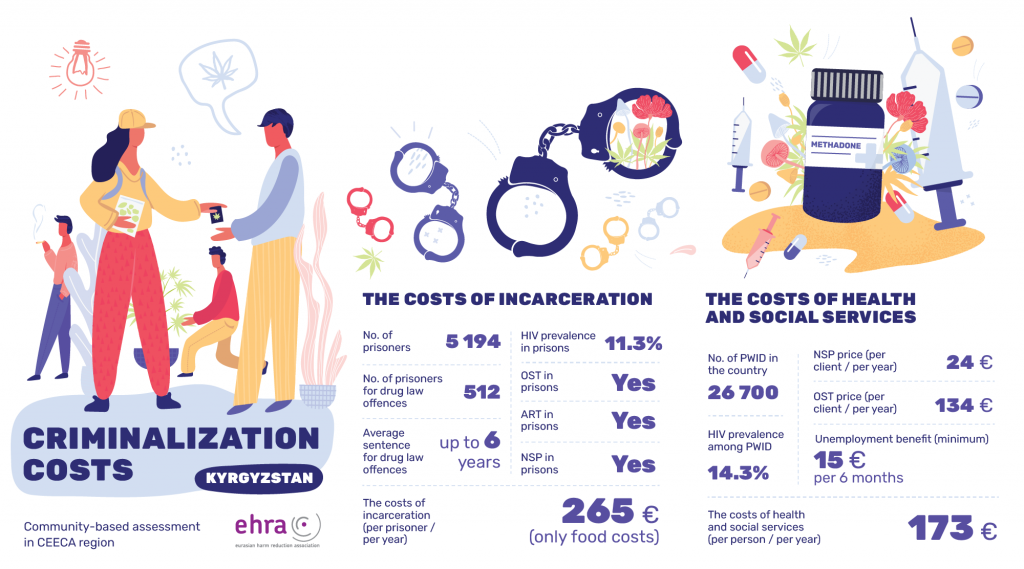Officially, there were 5,194 people incarcerated in the prisons of Kyrgyzstan, of which 512 were imprisoned for drug-related crimes in 2020 [1]. The average imprisonment term imposed by the courts for drug law offences is up to 6 years [2]. HIV prevalence among prisoners was estimated in 2016 at 11.3% [3] and antiretroviral therapy (ART) is reportedly available in prisons [4]. Both opioid substitution therapy (OST) and needle/syringe programmes (NSP) are also reportedly available in Kyrgyz prisons [5].
Data on expenditures made by Government authorities on prisoners is sparse. According to one media report in February 2019, the Government spends €265 per year on food for each prisoner [6]. Other media from January 2020, using data from the State Penitentiary Service (GSIN), report expenditure to be around €200-€300 per prisoner, per year, and the entire annual budget for ‘the maintenance of prisoners’ is around €10 million [7].
The number of people who inject drugs in Kyrgyzstan was estimated to be 26,700 in 2016 [8] with HIV prevalence at 14.3% [9]. NSP costs €23.65 per client, per year, and OST costs €134 per client, per year [10]. Unemployment benefit is €15.00 per person covering a period of 6 months, or €2.50 per month. Unemployment benefits are paid to a citizen registered with the state employment service and officially recognised as unemployed and with continuous insurance contributions for at least 12 months in the previous 3 years [11].
Therefore, if all services were paid by the Government, the cost to assist one person who injects opioid drugs in community settings would be €173 per year. This contrast with up to €300 per year to keep that person in prison, a saving of €127 per drug user, per year. Consequently, decriminalisation of drug use and possession could save the Government of Kyrgyzstan up to €65,000 per year.
[1] Department of summary works and dissemination of statistical information. Official Statistics – Criminal, Number of convicts by type of crimes. Bishkek; National Statistical Committee of the Kyrgyz Republic, 2021. http://www.stat.kg/ru/statistics/download/dynamic/686/ (accessed 7 August 2021).
[2] Social Statistics Division. Control over the traffic in narcotic drugs, psychotropic substances and their precursors in the Kyrgyz Republic 2009-2017 Special Issue. Bishkek; The National Statistics Committee of the Kyrgyz Republic, 2018, p139. http://www.stat.kg/media/publicationarchive/57cfcd79-0d03-478f-8b43-09b88f580dfe.pdf (accessed 7 August 2021).
[3] Kadyrbekov UK, Bekbolotov AA, Asybalieva NA, Akmatova ZK, Kubatova AK, et al. Results of Sentinel Surveillance for HIV Infection in Kyrgyzstan 2016. Bishkek; Republican AIDS Center, 2017, in, Davlidova S, Haley-Johnson Z, Nyhan K, Farooq A, Vermund SH, Syed Ali S. Prevalence of HIV, HCV and HBV in Central Asia and the Caucasus: A systematic review. International Journal of Infectious Diseases, Vol. 104, 2021, pp510-525. https://doi.org/10.1016/j.ijid.2020.12.068 (accessed 7 August 2021).
[4] Harm Reduction International (HRI). Global State of Harm Reduction 2020, Regional Overview 2.2 Eurasia. London; HRI, 2021. https://www.hri.global/files/2020/10/26/Global_State_HRI_2020_2_2_Eurasia_FA_WEB.pdf (accessed 3 August 2021).
[5] Ibid.
[6] Dzhumashova A. Kyrgyzstan spends 43,000 soms on food per prisoner annually. Bishkek; 24.kg News Agency, 8 February 2019. https://24.kg/english/108605_Kyrgyzstan_spends_43000_soms_on_food_per_prisoner_annually/ (accessed 7 August 2021).
[7] Sputnik. How much money is spent on the maintenance of one prisoner in the Kyrgyz Republic – infographic. Bishkek; Sputnik, 30 January 2020. In Russian. https://ru.sputnik.kg/infographics/20200130/1046916285/kyrgyzstan-koloniya-tyurma-sizo-zaklyuchennyj-soderzhanie-summa.html (accessed 7 August 2021).
[8] Scutelniciuc O. Methods and results of 2016 Size Estimation Exercise in Kyrgyzstan: Service Multipliers to Estimate the Size of People Who Inject Drugs, Female Sex Workers and Men having Sex with Men. Bishkek; Joint United Nations Programme on HIV and AIDS (UNAIDS), 2018. http://www.afew.kg/upload/files/Narrative_methods_results_KG_SE_03_01_2018.pdf (accessed 7 August 2021).
[9] Kadyrbekov UK, et al, Ibid.
[10] Information submitted by national partners.
[11] Transparency International Kyrgyzstan. How to register as unemployed and apply for unemployment benefits? Bishkek; Transparency International Kyrgyzstan, 24 January 2019. https://askjournal.kg/instructions/10/14.html (accessed 7 August 2021).

